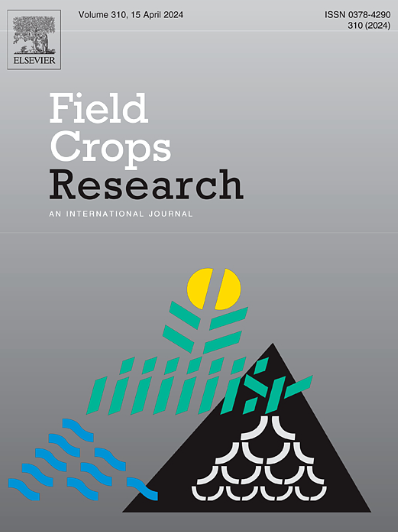Time-series NDVI and greenness spectral indices in mid-to-late growth stages enhance maize yield estimation
IF 5.6
1区 农林科学
Q1 AGRONOMY
引用次数: 0
Abstract
Accurate and timely satellite-based yield estimation is crucial for agricultural policy and food security. The Normalized Difference Vegetation Index (NDVI), which represents canopy greenness, is widely used to predict crop yields. However, most studies have developed empirical models based only on the relationship between instantaneous spectral information and final yield, ignoring the canopy physiological changes that can be captured by spectral monitoring during crop yield formation, which limits the applicability of these models. In this study, based on time-series NDVI data, we found that the trend of NDVI changes in the mid-to-late stages of maize is closely related to yield, and accordingly constructed four greenness spectral indices: NDVI decline rate (DR), average daily accumulation of NDVI (ADA), time-series NDVI standard deviation (STD), and leaves greenness duration (LGD). We assessed the validity of the GSIs under two scenarios: (1) When the time-series data were consistent across years, using three strategies, namely utilizing the complete NDVI datasets, estimating yield in advance, and accounting for missing data due to meteorological conditions; (2) We ask whether the GSIs remain valid when the time-series data are inconsistent across years. Results under time-series consistency showed that combining these GSIs derived from the complete NDVI dataset with the third-period NDVI achieved the highest model accuracy (R2 = 0.7, rRMSE = 12.3 %). Approximately one month before harvest, GSIs improved estimation accuracy (R2 = 0.661, rRMSE = 13.2 %), increasing R2 by 0.023 and reducing rRMSE by 0.4 %. When NDVI data were incomplete due to meteorological conditions, GSIs still enhanced yield estimation, increasing R2 by 0.007–0.077 and reducing rRMSE by 0.1 %-1.1 %. Even with the inconsistency of time-series data across years, the accuracy of yield estimation improved by 28 % after integrating GSIs. These results demonstrate the adaptability and reliability of GSIs under different conditions.
中后期NDVI和绿度光谱指数对玉米产量的预测有一定的促进作用
准确和及时的卫星产量估算对农业政策和粮食安全至关重要。归一化植被指数(NDVI)是一种反映冠层绿度的指数,被广泛用于作物产量预测。然而,大多数研究只建立了基于瞬时光谱信息与最终产量关系的经验模型,忽略了作物产量形成过程中光谱监测所能捕捉到的冠层生理变化,限制了这些模型的适用性。本研究基于时间序列NDVI数据,发现玉米中后期NDVI变化趋势与产量密切相关,据此构建了4个绿度光谱指数:NDVI递减率(DR)、NDVI日均积累量(ADA)、时间序列NDVI标准差(STD)和叶片绿度持续时间(LGD)。我们在两种情景下对gsi的有效性进行了评估:(1)在时间序列数据一致的情况下,采用三种策略,即利用完整的NDVI数据集、提前估算产量和考虑气象条件导致的缺失数据;(2)在不同年份的时间序列数据不一致时,gsi是否仍然有效。结果表明,在时间序列一致性条件下,将完整NDVI数据集的gsi与第三期NDVI相结合,模型精度最高(R2 = 0.7, rRMSE = 12.3 %)。大约在收获前一个月,gsi提高了估计精度(R2 = 0.661, rRMSE = 13.2 %),R2增加0.023,rRMSE降低0.4 %。在气象条件导致NDVI数据不完整的情况下,gsi仍能提高产量估算,R2提高0.007 ~ 0.077,rRMSE降低0.1 % ~ 1.1 %。即使在不同年份的时间序列数据不一致的情况下,整合gsi后的产量估算精度提高了28% %。这些结果证明了gsi在不同条件下的适应性和可靠性。
本文章由计算机程序翻译,如有差异,请以英文原文为准。
求助全文
约1分钟内获得全文
求助全文
来源期刊

Field Crops Research
农林科学-农艺学
CiteScore
9.60
自引率
12.10%
发文量
307
审稿时长
46 days
期刊介绍:
Field Crops Research is an international journal publishing scientific articles on:
√ experimental and modelling research at field, farm and landscape levels
on temperate and tropical crops and cropping systems,
with a focus on crop ecology and physiology, agronomy, and plant genetics and breeding.
 求助内容:
求助内容: 应助结果提醒方式:
应助结果提醒方式:


